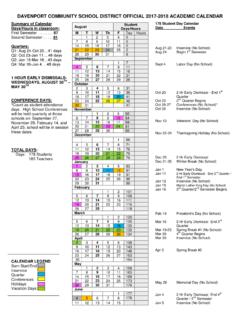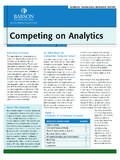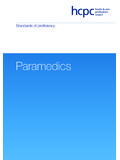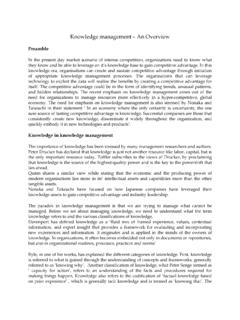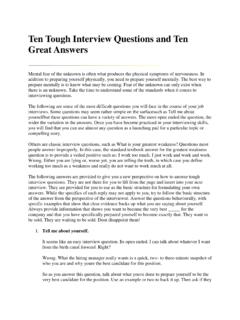Transcription of Alan G. Davenport Wind Engineering Group
1 alan g . Davenport wind Engineering Group The Boundary Layer wind Tunnel Laboratory wind TUNNEL TESTING: A GENERAL OUTLINE May 2007 The University of Western Ontario, Faculty of Engineering Science London, Ontario, Canada N6A 5B9; Tel: (519) 661-3338; Fax: (519) 661-3339 Internet: ; E-mail: wind TUNNEL TESTING: - i - alan g . Davenport wind Engineering Group A GENERAL OUTLINE TABLE OF CONTENTS 1 INTRODUCTION 1 2 THE MODELLING OF THE SITE AND THE wind 2 General 2 Scaling 2 3 THE CLADDING LOADS TESTS 3 Pressures and Suctions on Exterior Surfaces 3 Scaling 3 Internal Pressures and Differential Pressures 3 4 THE DETERMINATION OF OVERALL STRUCTURAL LOADS AND RESPONSES 4 Introduction 4 The Force Balance Test 4 The Two-degree-of-freedom Aeroelastic Test 5 The Multi-degree-of-freedom Aeroelastic Test 5 Overall Loads from Local Pressure Measurements 6 Effective Static Force Distribution 6 Load Combination Factors 7 5 THE PEDESTRIAN LEVEL wind SPEED TEST 8 6 THE TESTING OF LONG SPAN BRIDGES 9 7 OTHER TESTS 10 REFERENCES 11 APPENDIX A A-1 THE DEFINITION OF wind CLIMATE
2 A-1 Introduction A-1 Natural wind A-1 Availability of wind Records A-2 Probability Distribution of Mean wind Speed and Direction A-3 Applicability of the wind Climate Model A-4 APPENDIX B B-1 THE DEFINITION OF A HURRICANE wind CLIMATE B-1 Introduction B-1 The Approach Used B-1 Verifying the Approach B-2 The wind Climate for a Particular Site B-2 APPENDIX C C-1 THE MEASUREMENT AND PREDICTION OF SURFACE PRESSURE C-1 Experimental Technique C-1 Experimental Time Scale C-1 Choice of Sampling Period C-2 Definition of the Pressure Coefficients C-2
3 wind TUNNEL TESTING: - ii - alan g . Davenport wind Engineering Group A GENERAL OUTLINE General Characteristics of the Pressure Response C-3 Predictions of Peak Pressures and Suctions C-3 Limitations on the Predicted Peak Pressures and Suctions C-3 APPENDIX D D-1 PREDICTING PEAK RESPONSES FOR VARIOUS RETURN PERIODS D-1 Introduction D-1 The Prediction Process D-1 The Rate of Up-crossing of Peak (Maximum or Minimum) Response Values D-2 APPENDIX E E-1 STORM PASSAGE PREDICTIONS OF wind LOADS AND RESPONSES E-1 Overview E-1 Extreme-value Predictions from Time-domain Analysis E-1 Examples of Predictions of wind Loads and Effects E-2 wind Directionality E-3 APPENDIX F F-1 DETERMINATION OF INTERNAL PRESSURE COEFFICIENTS AND THE FORMATION OF DIFFERENTIAL PRESSURE COEFFICIENTS F-1 Summary F-1 Introduction F-1 Mean Internal Pressures.
4 Distributed Leakage F-1 Mean Internal Pressures: Large Openings F-2 Fluctuating Internal Pressures F-3 Forming Differential Pressure Coefficients at BLWTL F-4 Limitations of Predicted Differential Pressures F-5 APPENDIX G G-1 DETERMINATION OF TOTAL DYNAMIC LOADS USING A RIGID MODEL/FORCE BALANCE TECHNIQUE G-1 Summary G-1 Introduction G-1 Concepts of the Force Method G-1 Concept of the Balance
5 G-2 Linear Elastic Response Calculations with the BLWT Balance G-2 Torsional Response G-4 APPENDIX H H-1 AEROELASTIC SIMULATIONS OF BUILDINGS USING TWO-DEGREE-OF-FREEDOM MODELS H-1 Introduction H-1 Aeroelastic Modelling H-1 Details of the Aeroelastic Model H-2 Experimental Procedure and Preliminaries H-2 Predictions of Peak wind -Induced Response H-3 APPENDIX I I-1 AEROELASTIC SIMULATIONS OF BUILDINGS USING MULTI-DEGREE-OF-FREEDOM MODELS I-1 Introduction I-1 Aeroelastic Modelling I-1 wind TUNNEL TESTING: - iii - alan g .
6 Davenport wind Engineering Group A GENERAL OUTLINE Details of the Aeroelastic Model I-2 Experimental Procedure and Preliminaries I-2 Predictions of Peak wind -induced Response I-3 APPENDIX J J-1 DETERMINATION OF TOTAL DYNAMIC LOADS FROM THE INTEGRATION OF SIMULTANEOUSLY MEASURED PRESSURES J-1 Summary J-1 The Integration Procedure J-1 Response Calculations J-1 APPENDIX K K-1 THE EVALUATION AND USE OF EFFECTIVESTATIC FORCE DISTRIBUTIONS K-1 Effective Static Force Distributions K-1 Combined Load Cases K-2 APPENDIX L L-1 THE PEDESTRIAN LEVEL wind ENVIRONMENT L-1 Introduction L-1 Test Procedure L-1 Statistical Predictions of Pedestrian Level Winds L-1 Acceptance and Safety Criteria
7 For Pedestrian Level wind Conditions L-2 APPENDIX M M-1 DYNAMIC wind FORCES ON LONG SPAN BRIDGES USING EQUIVALENT STATIC LOADS M-1 Introduction M-1 The Description of Design Loads M-1 Evaluation of the Modal Load W and W12 M-1 Experimental Determination of Design Load Components M-4 Determination of Design wind Loads M-4 Conclusions M-5 wind TUNNEL TESTING: - iv - alan g . Davenport wind Engineering Group A GENERAL OUTLINE LIST OF TABLES TABLE CRITERIA FOR PEDESTRIAN COMFORT AND TABLE EXTRACTS FROM THE BEAUFORT wind TUNNEL TESTING: - v - alan g .
8 Davenport wind Engineering Group A GENERAL OUTLINE LIST OF FIGURES FIGURE COMPARISON OF TYPHOON wind SPEEDS AT WAGLAN ISLAND TO MEASURED DATA CORRECTED FOR TOPOGRAPHIC B-5 FIGURE PREDICTED PEAK ACCELERATIONS FOR THE ALLIED BANK DURING HURRICANE B-6 FIGURE ILLUSTRATION OF THE PREDICTION D-4 FIGURE OBSERVED 10-MINUTE AVERAGE SURFACE wind SPEED AND wind DIRECTION AT HONG KONG DURING TYPHOON YORK (SEPTEMBER 16, 1999).. E-5 FIGURE TYPICAL wind INDUCED RESPONSE E-5 FIGURE COMPARISON OF GENERIC wind LOADS AND EFFECTS PREDICTED FOR DIFFERENT wind DIRECTIONS USING CONVENTIONAL STATISTICAL METHODS AND TRACKING THE EFFECTS OF INDIVIDUAL E-6 FIGURE COMPARISON OF PEAK STRUCTURAL wind LOAD EFFECTS FOR BUILDINGS A AND B HYPOTHETICALLY LOCATED IN DIFFERENT wind REGIONS PREDICTED BY CONVENTIONAL STATISTICAL METHODS AND BY TRACKING THE EFFECTS OF INDIVIDUAL E-6 FIGURE COMPARISONS OF PREDICTED LOCAL PEAK PRESSURES AND SUCTIONS FOR A SPECIFIC BUILDING AND FOR A GENERIC PRESSURE COEFFICIENT DATA SET IN DIFFERENT wind REGIONS USING CONVENTIONAL STATISTICAL METHODS AND BY TRACKING THE EFFECTS OF INDIVIDUAL E-7 FIGURE DIRECTIONALITY FACTORS FOR GENERIC PEAK STRUCTURAL LOADS AND RESPONSES USING CONVENTIONAL PREDICTIVE METHODS AND STORM
9 PASSAGE E-7 FIGURE DYNAMIC RESPONSE OF THE BALANCE-MODEL G-6 FIGURE SCHEMATIC OF THE AEROELASTIC H-4 FIGURE SCHEMATIC OF THE AEROELASTIC FIGURE DISTRIBUTED wind LOAD FIGURE FIGURE SPECTRUM OF MODAL LOAD FIGURE SUNSHINE SKYWAY FIGURE SECTION MODEL RESPONSE (UNCORRECTED)..M-8 FIGURE VERTICAL VELOCITY FIGURE AERODYNAMIC ADMITTANCE RESPONSE (UNCORRECTED)..M-9 wind TUNNEL TESTING: - vi - alan g . Davenport wind Engineering Group A GENERAL OUTLINE FIGURE JOINT ACCEPTANCE FIGURE DAMPING FIGURE wind LOAD COMPONENTS ON COMPLETED wind TUNNEL TESTING: - 1 - alan g . Davenport wind Engineering Group A GENERAL OUTLINE 1 INTRODUCTION This document provides a general outline of common wind tunnel tests performed at the Boundary Layer wind Tunnel Laboratory (BLWTL) at the University of Western Ontario.
10 It also details some of the techniques used to analyse the data from these tests. Since it is a general outline, it will cover some tests and analyses not performed for a particular project. Other than the wind climate modelling discussed in Section 2 and Appendices A and B, and the prediction methodology discussed in Appendices D and E, the various tests and analysis methodology are independent and the reader may skip sections that are not relevant. Also, this report does not, by any means, attempt to cover all of the types of tests and analyses performed at the Laboratory. Unusual tests are covered in separate reports for the projects employing them. In determining the effects of wind for a particular development, there are two main ingredients to consider.

